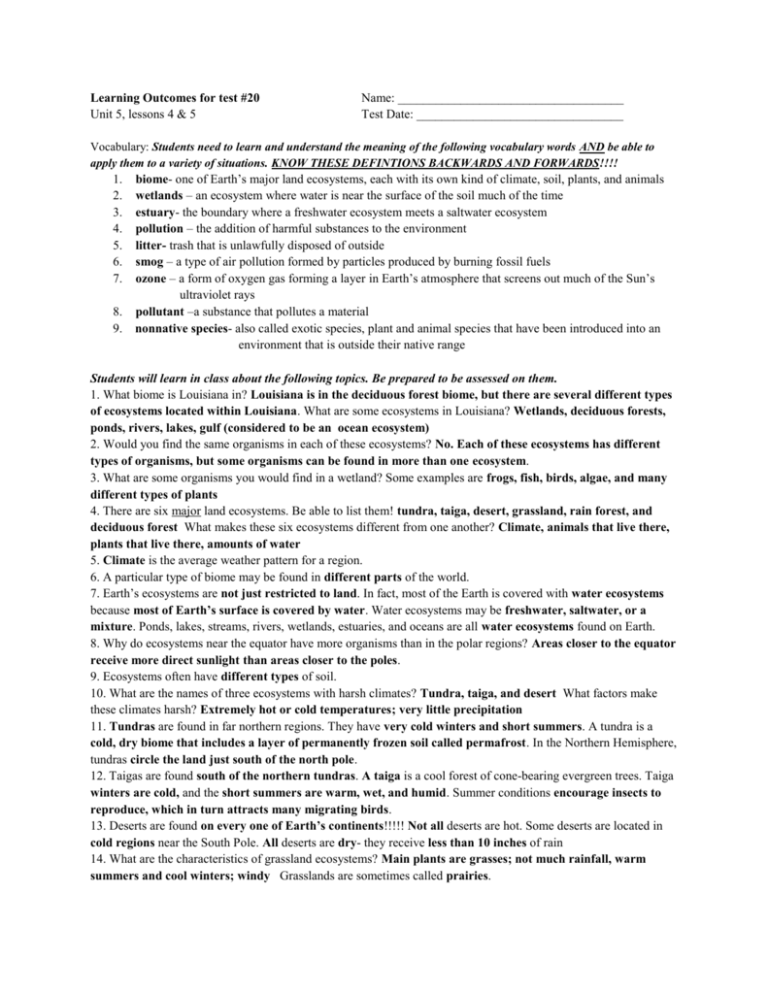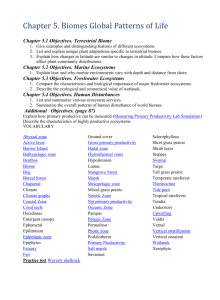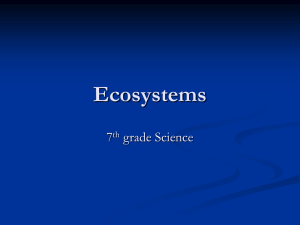Learning Outcomes for test #20 Name: Unit 5, lessons 4 & 5 Test
advertisement

Learning Outcomes for test #20 Unit 5, lessons 4 & 5 Name: ____________________________________ Test Date: _________________________________ Vocabulary: Students need to learn and understand the meaning of the following vocabulary words AND be able to apply them to a variety of situations. KNOW THESE DEFINTIONS BACKWARDS AND FORWARDS!!!! 1. 2. 3. 4. 5. 6. 7. 8. 9. biome- one of Earth’s major land ecosystems, each with its own kind of climate, soil, plants, and animals wetlands – an ecosystem where water is near the surface of the soil much of the time estuary- the boundary where a freshwater ecosystem meets a saltwater ecosystem pollution – the addition of harmful substances to the environment litter- trash that is unlawfully disposed of outside smog – a type of air pollution formed by particles produced by burning fossil fuels ozone – a form of oxygen gas forming a layer in Earth’s atmosphere that screens out much of the Sun’s ultraviolet rays pollutant –a substance that pollutes a material nonnative species- also called exotic species, plant and animal species that have been introduced into an environment that is outside their native range Students will learn in class about the following topics. Be prepared to be assessed on them. 1. What biome is Louisiana in? Louisiana is in the deciduous forest biome, but there are several different types of ecosystems located within Louisiana. What are some ecosystems in Louisiana? Wetlands, deciduous forests, ponds, rivers, lakes, gulf (considered to be an ocean ecosystem) 2. Would you find the same organisms in each of these ecosystems? No. Each of these ecosystems has different types of organisms, but some organisms can be found in more than one ecosystem. 3. What are some organisms you would find in a wetland? Some examples are frogs, fish, birds, algae, and many different types of plants 4. There are six major land ecosystems. Be able to list them! tundra, taiga, desert, grassland, rain forest, and deciduous forest What makes these six ecosystems different from one another? Climate, animals that live there, plants that live there, amounts of water 5. Climate is the average weather pattern for a region. 6. A particular type of biome may be found in different parts of the world. 7. Earth’s ecosystems are not just restricted to land. In fact, most of the Earth is covered with water ecosystems because most of Earth’s surface is covered by water. Water ecosystems may be freshwater, saltwater, or a mixture. Ponds, lakes, streams, rivers, wetlands, estuaries, and oceans are all water ecosystems found on Earth. 8. Why do ecosystems near the equator have more organisms than in the polar regions? Areas closer to the equator receive more direct sunlight than areas closer to the poles. 9. Ecosystems often have different types of soil. 10. What are the names of three ecosystems with harsh climates? Tundra, taiga, and desert What factors make these climates harsh? Extremely hot or cold temperatures; very little precipitation 11. Tundras are found in far northern regions. They have very cold winters and short summers. A tundra is a cold, dry biome that includes a layer of permanently frozen soil called permafrost. In the Northern Hemisphere, tundras circle the land just south of the north pole. 12. Taigas are found south of the northern tundras. A taiga is a cool forest of cone-bearing evergreen trees. Taiga winters are cold, and the short summers are warm, wet, and humid. Summer conditions encourage insects to reproduce, which in turn attracts many migrating birds. 13. Deserts are found on every one of Earth’s continents!!!!! Not all deserts are hot. Some deserts are located in cold regions near the South Pole. All deserts are dry- they receive less than 10 inches of rain 14. What are the characteristics of grassland ecosystems? Main plants are grasses; not much rainfall, warm summers and cool winters; windy Grasslands are sometimes called prairies. 15. What are the differences between a tropical rain forest and a deciduous forest? Tropical rain forest: warm, humid climate; much rainfall; located near the equator Deciduous forest: trees lose leaves during fall and winter; warm summers and cold winters 16. Temperate rainforests have milder (lower) temperatures than tropical rain forests and less rainfall. 17. What type of freshwater ecosystems are in Louisiana? Ponds and lakes, rivers and streams, wetlands 18. How are streams and rivers different from ponds and lakes? Ponds and lakes contain nonmoving water yearround. Streams and rivers have moving water. 19. Why are wetlands important ecosystems? They are rich in plant life, homes to many living things and important breeding grounds for birds and other animals. They also serve as natural water filters and sponges by removing pollutants and protecting surrounding land from floods and erosion. 20. Why are estuaries unique ecosystems? Because the water is part salt water and part freshwater 21. About 40% of the wetlands in the continental United States are in Louisiana. Wetlands include marshes, swamps, and bogs. 22. The plants and animals that live in estuaries have adaptations that help them survive in variations in salt content, or salinity. 23. Ocean food chains include plankton, nekton, and benthos. Plankton live near the ocean’s surface. They make up the base of the ocean food chain. Nekton, such as squid, fish, and dolphins, swim through the water. Benthos, such as crabs, sponges, and corals, are bottom- dwelling animals that live on or near the ocean floor. 24. The three ocean zones are intertidal zone (closest to shore), neritic zone, and oceanic zone. Which ocean zone would not have algae growing on the ocean floor and why? The oceanic zone because sunlight cannot reach the floor of the ocean. How does depth affect ocean water’s temperature? Temperature decreases as depth increases. 25. Holes in Earth’s ozone are a problem because they allow dangerous rays from the Sun to reach Earth’s surface. These rays can cause skin cancer. Smog can cause breathing problems. 26. The best way to protect our water resources is to prevent water pollution. 27. Soil is the mixture of rock and bits of once living parts of plants and animals that covers most of Earth’s landmasses. What are some ways in which soil can become polluted? Waste is not disposed of properly, underground storage tanks can leak, chemicals used on crops can get in the soil, if landfills are not properly constructed they can leak, people litter 28. What are some negative effects of soil pollution on the environment? Harmful substances can be washed into streams and rivers; the soil chemistry can change; the health of humans and other organisms can be affected 29. Air pollution can be produced by contaminants from burning fossil fuels or trash, dust from plowing fields, activity at construction sites and mines, chemicals from factories, smoke from cars or trucks, and ash from erupting volcanoes. 30. How does forest destruction affect air pollution? Because forests give off oxygen and use carbon dioxide, cutting down forests might reduce the oxygen content of the air and increase its carbon dioxide content. 31. The ozone layer is the layer of gas in the atmosphere that protects living things from the Sun’s harmful rays. 32. What are some ways in which water can become contaminated, or polluted? Chemicals used on crops and on lawns can seep into groundwater; water running over streets can pick up contaminants as it flows; and the nutrients and bacteria from animal waste can get washed into lakes and streams when it rains, becoming water pollutants. Polluted, or contaminated, water cannot safely be used by people for drinking, washing, cooking, or swimming. 33. What laws are in place to protect water resources? The Safe Drinking Water Act and the Clean Water Act 34. What are some ways people could prevent water pollution? People could reduce or eliminate the use of chemicals on their lawns; dispose of garbage properly; plant trees or shrubs to help absorb chemicals, animal waste, and sediment and keep them from entering streams. 35. Why are nonnative species a problem for some native plants and animals? The nonnative species can eat native organisms or they may compete with the native organisms for resources such as food and water. Often, they have no natural predators and are able to reproduce very rapidly. Nutria are a nonnative species in Louisiana that have damaged coastal wetlands through feeding and burrowing. 36. How does regulating hunting affect the population of an ecosystem? It helps to keep populations from growing too fast and getting too big. What factors would a wildlife manager consider to determine how many organisms in a population can be hunted? The carrying capacity of the ecosystem based on the resources available, the rate at which the organism can reproduce, the rate at which organisms are dying of natural causes or from other predators









